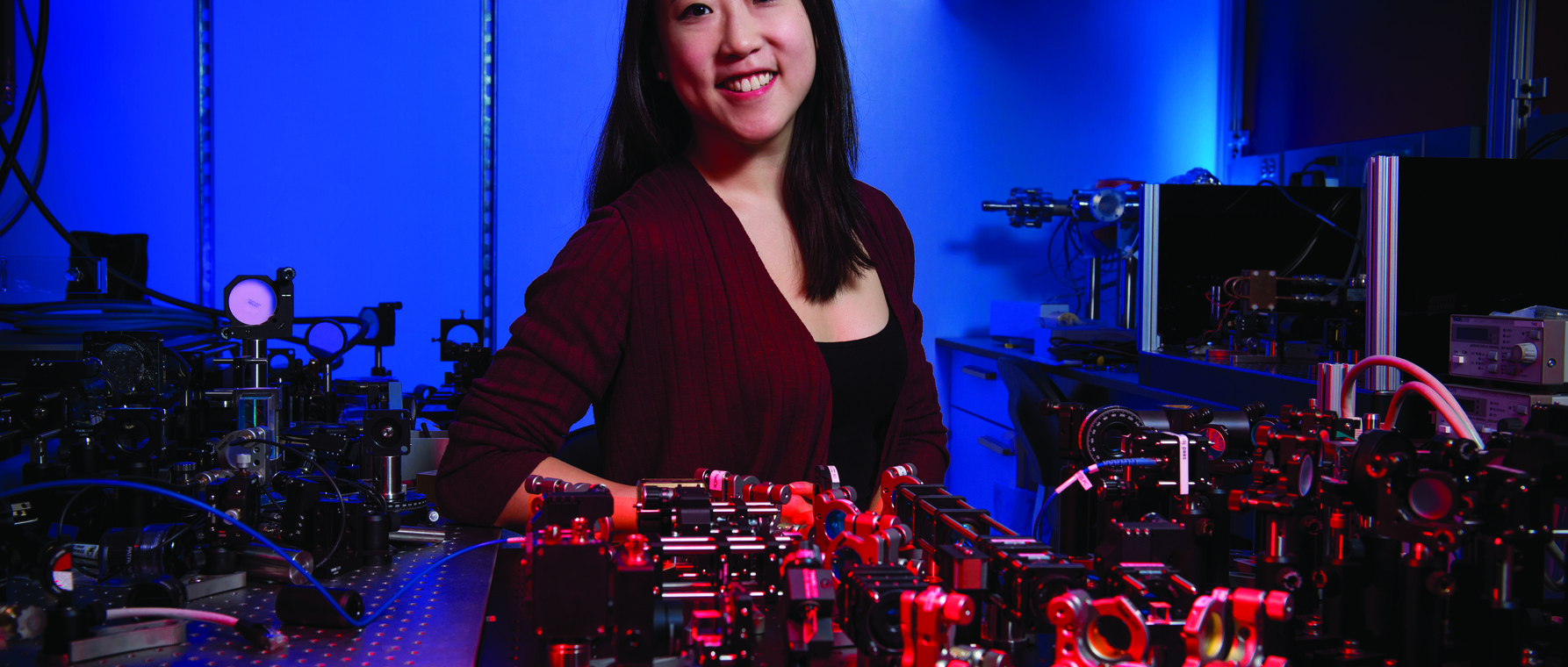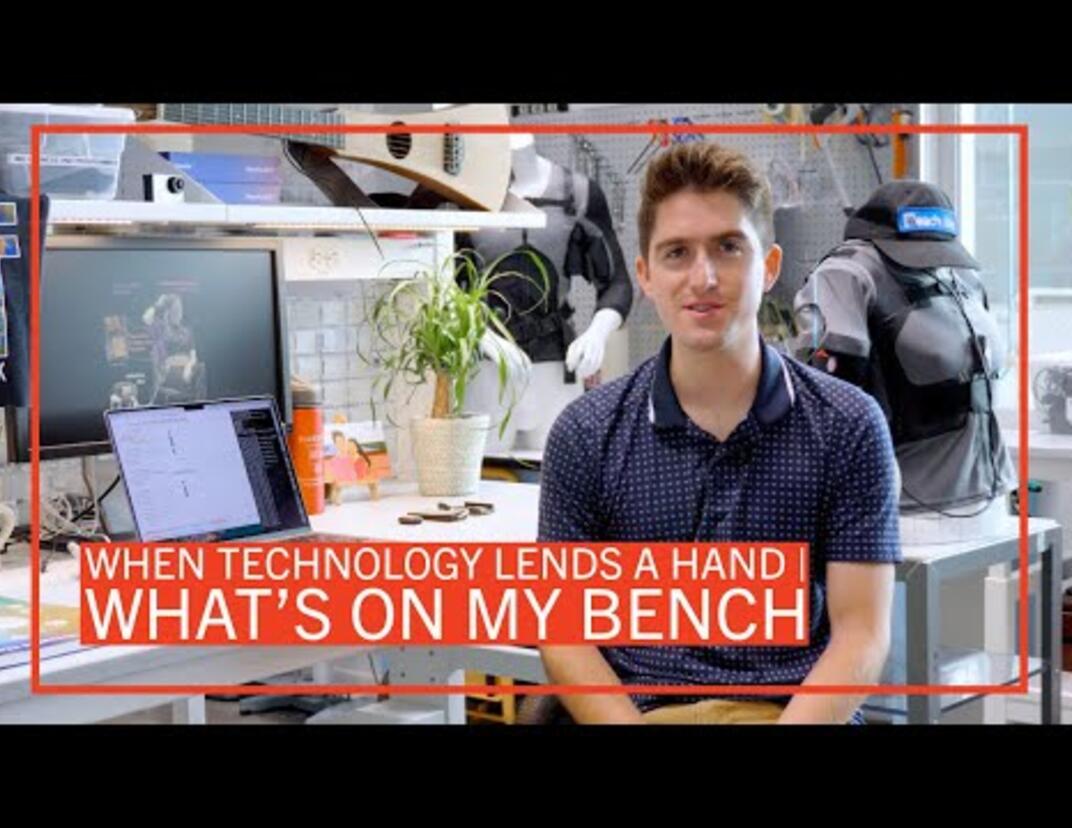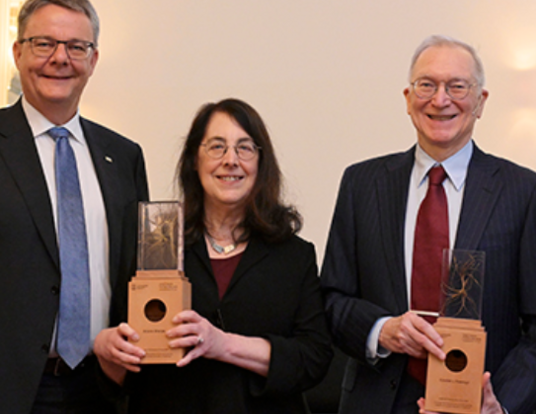Starting a Technology Revolution
Christie Chiu explores fundamental questions concerning high-temperature superconductors.

In a small room on the first floor of Lyman Labs are two rectangular tables covered in mirrors, amplifiers, fibers, and lenses. “Organized chaos would be a good description,” says Christie Chiu, a PhD candidate in physics. All the bits and pieces serve a single purpose: to manipulate and control laser beams strong enough to load and hold anywhere from 80 to 1,000 lithium atoms in a 2-dimensional lattice that is hidden away in a vacuum-chamber made of stainless steel and glass.
On a computer, Chiu pulls up a photograph of the lithium atoms held in the lattices, and one can easily see the mesh of atoms. “The fact that we can see the underlying lattice in this photograph without any image processing is already amazing,” says Chiu. Generating such a clear image was a challenging yet necessary step in Chiu’s research. “It means we know where the atoms are, and we can make reliable measurements,” she explains. As stunning as the lattice is, the properties of high-temperature superconductors that it will allow Chiu to explore are even cooler.
No Resistance
Imagine a world in which laptop computers don’t heat up and cell phone batteries last forever. It sounds like science fiction, but for physicists who study superconductors, it feels like an attainable reality. Superconductors are materials that can conduct electricity with zero resistance, which means zero heating and zero wear-and-tear. Unfortunately, their superconducting ability only occurs at very low temperatures: around 4 kelvins or minus 450 degrees Fahrenheit. Thirty years ago physicists discovered high-temperature superconductors, but despite their name, they still need to be chilled to 130 kelvins or minus 225 degrees Fahrenheit to be superconducting. “If we could bring that temperature all the way up to room temperature, that would be amazing,” Chiu says. “Technology as we know it would be revolutionized."
Before we can envision the development of room temperature superconductors, physicists must first understand the physical properties that allow high-temperature superconductors to conduct electricity with zero resistance. “We don’t have a good microscopic model for what causes this superconducting behavior. That’s what we’re trying to solve,” Chiu says.
Some scientists choose to look at high-temperature superconductors directly by studying samples of superconducting materials, but this approach has limitations. Chiu points out that it’s impossible for the sample to be completely pure, since nothing is perfectly clean in the laboratory. To create a perfect system devoid of impurities in which to probe the physical properties of superconductors, Chiu has turned to lasers. “Light is perfect,” Chiu states. “And laser light is very tunable, very clean, and that’s why it appeals to us.”
For Chiu, the lattice of laser light and lithium atoms is an analog of a high-temperature superconductor. “In a material you have a crystal of atoms with electrons moving around. This sea of electrons determines the electrical properties of the material, such as what resistance it has,” explains Chiu. “In our system we have a crystal created from laser light with lithium atoms moving around.”
This experimental system will allow Chiu to explore the fundamental questions concerning high-temperature superconductors. “What is the underlying mechanism governing superconductivity? What are the electrons doing inside of these materials,” Chiu asks. “And once we’ve answered these questions, we can take advantage of this knowledge to engineer a material that’s superconducting at room temperature."
A Sea of Analogies
Often when explaining her research, Chiu uses the classic analogy of an airplane wing in a wind tunnel. “Let’s say you want to build a very efficient airplane,” she begins. “You could build one airplane prototype and try to fly it. If that doesn’t work you try a second prototype and then a third until you succeed.” This approach however is costly and ineffective.
“So instead, you start with a model wing in an air tunnel and see how the air flows around it, what the underlying physics is. You then use that knowledge to engineer a wing that works,” Chiu explains. “We’re trying to do something similar with our atoms.” Instead of engineering a number of new materials that may or may not be superconducting, the atoms in a lattice will allow Chiu to understand high-temperature superconductors and, eventually, engineer a material that is superconducting at room temperature.
For Chiu, analogies like the airplane wing are essential when explaining physics. “Without analogies, we would be lost,” she laughs. In talking about her experiment, Chiu has compared the two-dimensional lattice to an egg carton and likened taking an image of the lithium atoms to trying to photograph a hyperactive child. “Our entire experiment is an analogy,” she points out.
Chiu used the airplane wing analogy in her application to Harvard Horizons, a program that recognizes GSAS PhD candidates doing incredible work at Harvard. Each year, eight students are selected and, under the mentorship of faculty fellows and the Derek Bok Center for Teaching and Learning, craft five-minute TED-style talks that they present at the Harvard Horizons Symposium, which this year will be held on April 11, 2018, at 4:30 p.m. in Sanders Theatre.
As part of the application to Harvard Horizons, applicants must submit a video in which they condense years of research into a one-minute pitch. While making her pitch, Chiu turned to her advisor Markus Greiner, professor of physics, lab mates, friends, and her family for feedback. “I basically practiced in front of anyone who would listen, even my pet bunny,” she confesses. “I knew I was on the right track when my dad said ‘Oh, now I understand what you’re doing!’ ”
Chiu was right, and last December she was named a 2018 Harvard Horizons Scholar, joining a diverse group of PhD candidates who study everything from urban planning to psychology. Between now and April, Chiu and her fellow Horizons scholars will meet at least once a week to refine their presentation skills and practice their talks. For Chiu, having this diverse sounding board has already proved useful. “My conversations with the other Horizons scholars as well as with the faculty fellows have helped me distill my story into the core message I want to communicate,” she says. “As for what that core message is, you’ll have to go to the symposium!”
When asked whether any analogies will make it into her talk, Chiu gives an emphatic yes. “With only five minutes, the key will be relying on every individual's prior knowledge and experience to communicate the complex ideas of my lab work,” explains Chiu. And for Chiu, analogies have the power to do just that. “They allow you to meet people where they are and build a bridge to the new material and the ideas you want to share with them.”
Photo by Stu Rosner
Get the Latest Updates
Join Our Newsletter
Subscribe to Colloquy Podcast
Simplecast




